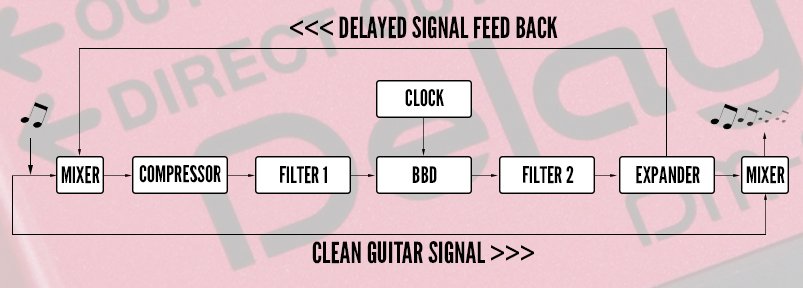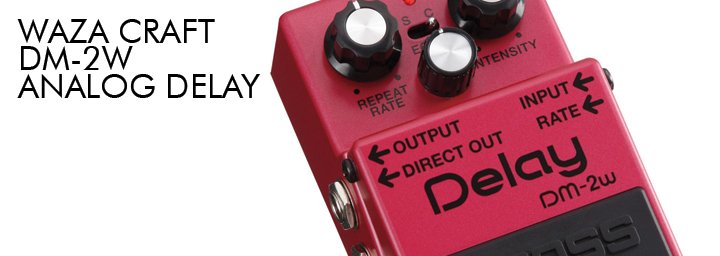The BOSS Talk article series takes a deeper look into all things effects pedals, and BOSS, to help you understand more about these inspiring sound-defining devices.
Contributed by Christian Moraga for the Roland Australia Blog
Subscribe to our blog so you can get the latest articles sent straight to your email so you don’t miss a tip, trick or info that will help you get the most out of your stompboxes!
In the first article, we look to dispel the myths, half-truths and urban legends at the core of the analog delay pedal, the BBD. BOSS made the first analog delay stompbox back in 1981 with the much-revered, BOSS DM-2, followed by the DM-3 in 1984. At the heart of the pedal is an integrated circuit chip that has fuelled pages of internet-chatter on “Which BBD is Best?”. As this article points out, there is much more to analog delay than one chip.
So, what is a BBD? We’re glad you asked…

THE DAWN OF DELAY
Check, check, check… One, one, one… Two, two, two…
No doubt, you have heard the delay effect before. Delay and rock music have shared a rich history together; from the first slapback effect heard on Elvis’ “That’s All Right” to the current powerful delay machines gracing the pedalboards of the stars. Delay and Roland/BOSS also share a connected past that includes the iconic tape-machine repeats of the Roland RE-201 Space Echo and the dark, warm echoes of the first analog stompbox, the BOSS DM-2 and DM-3. Delay has been a favoured effect for generations of guitarists, with many forming their signature sound around it. But when did delay first appear?
Some of the first delay effects were heard when a tape machine became the subject of an audio engineer’s experiment. They found that if a loop of tape was repeatedly recorded, played back and the input signal removed, a delayed signal was made of the original. This experiment opened up a world of wonderful effects that would leave a mark on the future of music to come.
However, tape delays were a pain to transport and contained fragile mechanical parts. There was a need for a compact, reliable and affordable delay option that guitarists could take with them anywhere. It wasn’t until a small advancement in electronic circuits saw the birth of analog delay and modulation stompboxes. That circuit is known as a Bucket Brigade Device and would change the effects world forever.
BBDs! HOW DO THEY WORK?
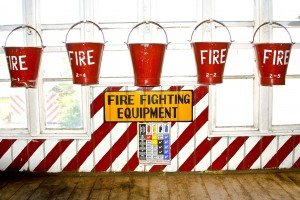
A Bucket Brigade Device (or BBD) is an analog circuit contained within a small chip that delays an incoming audio signal. This “circuit-within-a-circuit” was the main reason why an analog delay could fit into stompbox form. The term “Bucket Brigade” is a reference to the technique used by firefighters to put out a fire by passing buckets of water, one by one, down a line. To help explain how delay and BBDs work, let’s stick with that analogy.
The water in this example is the incoming guitar signal. The “buckets” in a BBD come in the form of a series of capacitors inside the chip. Capacitors “carry” the signal much like the buckets carry the water. Because the capacitors are continuously filling and emptying, this slows down or “delays” the signal as it takes more time to pass through the BBD.
But an analog delay is made up of much more than a single BBD chip. Much of the overall sound comes from the design of the circuit “blocks” around the BBD. Engineers face a delicate juggling act when designing these circuit blocks as they can make, or break, a great analog delay tone.
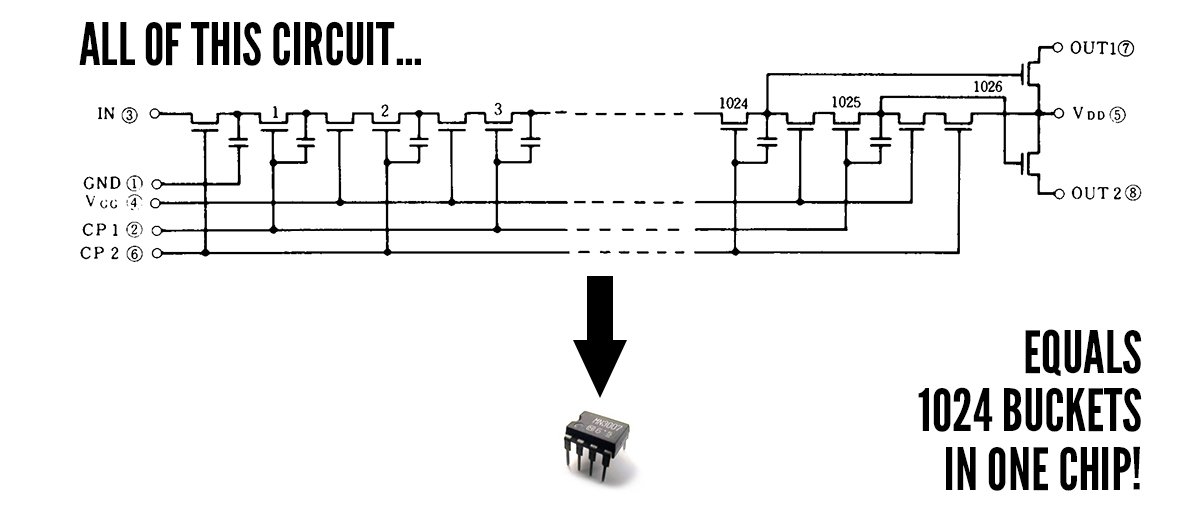
WHY DOES AN ANALOG DELAY SOUND SO WARM AND SMOOTH?
Imagine a line of 1024 firefighters, each passing a bucket of water to each other… that’s a fair amount of spillage. This spillage also occurs in the BBD meaning more noise and distortion added to the signal. Add to that the “ticking” noise introduced by the CLOCK (refer to the LET’S GET TECHNICAL! Section) and you have a signal that needs some clever filtering to get rid of the unwanted noise. This filtering leads to a delay signal that is much “darker” than the input guitar signal.
This frequency difference between the clean and delayed signal is what gives analog delay its desired response. The dark repeats wash away in the background and don’t get “in the way” of your original guitar signal.
So there you have it! The characteristic warm, smooth and organic sound of an analog delay is actually due to its limitations and not because of any mystical mojo in a chip. Effects with BBDs at its core are a great example of how an effect can inspire a whole generation of music and artists – even though it technically isn’t a “perfect design”. That’s where the journey of digital delay comes in to the discussion… but let’s leave that for another day.
WAZA CRAFT
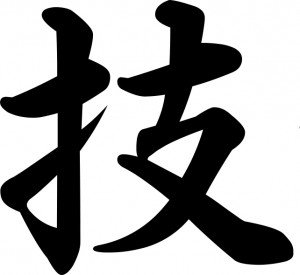
“Waza” is a Japanese term that translates to “art and technique”. Waza Craft engineering is a culmination of BOSS’ accumulated expertise, enthusiasm and passion for ultimate sound craftsmanship. Why does a BOSS analog pedal need such high class engineers? Because there is a lot more to an analog delay than just the BBD…
Each block requires specific tuning, calibration and engineering to ensure the delay output has low distortion, low noise while retaining the classic warm repeats that make an analog delay.
The new Waza Craft DM-2W is a great example of how it takes world-class engineering to deliver the analog tones the guitar world has come to love in the original DM-2.
The BOSS engineers have applied meticulous attention-to-detail by analysing every component in each block of the original DM-2 to recreate the same nuances and response for the DM-2W. Only the BOSS Waza Craft engineering team holds the key to achieve this feat and have successfully managed to reinvent an analog delay for a new generation of guitarist.
LET’S GET TECHNICAL! [ADVANCED SECTION]
Are you ready for some nerdy analog-delay, electronics talk? This section goes deep into the analog delay circuit to understand each of these circuit blocks.
In order for a BBD to work, it requires additional circuit blocks. To understand the circuit, let’s follow the block diagram below from input to output
► INPUT MIXING CIRCUIT – the guitar signal is split into two signals: One signal goes straight through to the COMPRESSOR block. The other split signal goes through to the OUTPUT MIXER STAGE. The signal going through to the BBD must have low distortion, low noise and have a narrower bandwidth in order for the BBD to work efficiently. That’s where compression and filtering comes in.
► COMPRESSOR (COMPANDER) – A guitar signal has a wide dynamic response with a range of low output and high output peaks dependent on your style of playing. The BBD doesn’t like this response so the signal is compressed to maximise the amount of gain of the signal going into the BBD. This helps reduce distortion on the repeats while keeping noise as low as possible (maintaining a good signal-to-noise ratio).
► FILTER 1 (ANTI-ALIASING) – BBDs don’t like high-frequency audio as it can introduce aliasing artefacts into the delayed signal. A low-pass filter rounds off the troubling high frequency, making the signal ready for the BBD.
► BBD – You know all about this now! A series of “buckets” that pass audio from one to the other creating that time-delay effect. Refer to the “BBDs! HOW DO THEY WORK?” section.
► CLOCK – Think of the clock as a metronome: A constant ticking pulse that tells the BBD to move the audio from one stage (bucket) to the next. The RATE knob on the delay pedal controls the speed of the clock. A fast rate means a slapback delay, a long rate means a long delay time.
► FILTER 2 (RECOVERY) – the signal output from the BBD is now a sampled signal and needs to be “smoothed” out in order for the EXPANDER section to work efficiently. In addition, the CLOCK circuit introduces a “ticking” noise whenever the pedal is on. Applying another low-pass filter helps reduce the clock noise and smooths out the signal for dynamic range expanding.
► EXPANDER – As opposed to the COMPRESSOR stage, the expander takes the delayed signal from the BBD and expands the dynamic range as close as possible to the initial input signal. The signal response is now very similar to the original input signal but has a darker tone as it has passed through two filters.
► FEEDBACK – a portion of the delayed signal is now split off and “fed back” into the compressor stage. This feedback is what creates the trailing echo effect. More signal fed back means more repeats, controlled by the INTENSITY control. Too much signal fed back into the circuit leads to oscillation – that awesome space-ship effect that is a signature sound for analog delays.
► OUTPUT MIXER – The original split guitar and the darker delayed signal are mixed together, with the blending of the two signals (“wet” for delayed signal, “dry” for the original signal) controlled by the ECHO knob.
That’s it. You have just powered up to “Circuit Guru!”.
There is much more to an analog delay than mojo, or the number written on a BBD chip. It is more about the detailed engineering design that goes around it that gives the delay the character it is known for. So when you next get lost in those rich, dark repeats of your analog delay, hopefully you can appreciate the amount of work that has gone into giving you your favourite delay effect.
Please subscribe to our blog for future articles in the BOSS Talk series.
RELATED PRODUCTS
Image: Joerg Hackemann / 123RF

